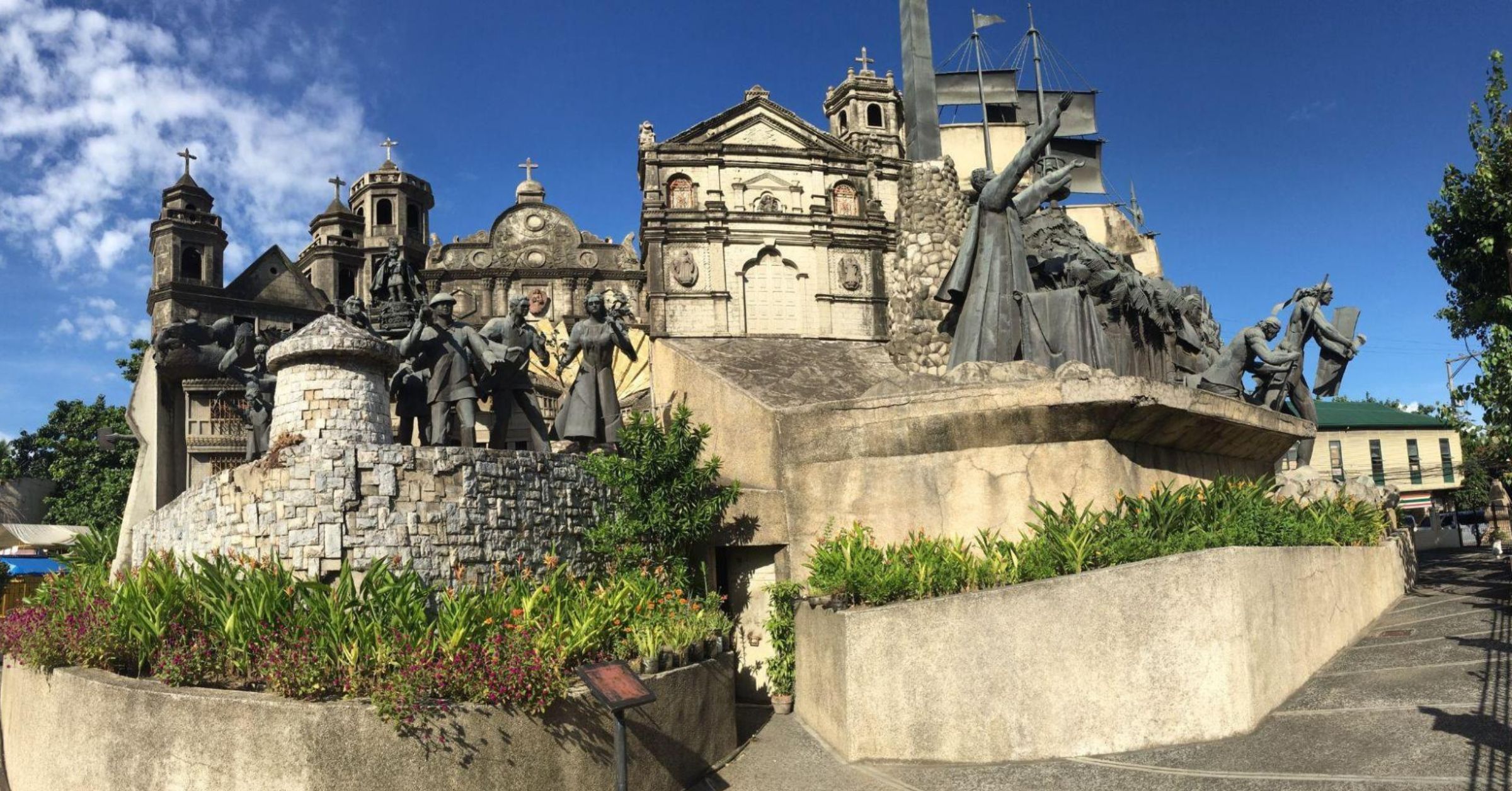Right in the center of historic Barangay Pari-an is a tourist attraction that stands tall with its rigid features consisting of sculptures made of brass, bronze, concrete, and steel.
Multi-awarded national artist Eduardo Castrillo designed the monument and depicts scenes about historic events that define the history of Cebu. The late Cebuano Senator Marcelo Fernan and other private individuals and organizations funded the construction of the monument, which was built in July 1997 and finished in December 2000.
The Heritage of Cebu monument depicts scenes from the time of Rajah Humabon, a Catholic Mass, the fateful battle on April 21, 1521 in the island of Mactan where warriors of native chieftain Lapulapu killed Ferdinand Magellan. It also includes the Basilica Del Sto. Nino, Cebu Metropolitan Cathedral, the San Juan Bautista Church, Magellan’s Cross, a Spanish Galleon, Statues of Sergio Osmena Sr., and Blessed Pedro Calungsod.

Numerous tourists would come and take photos of the monument every day.
Barangay tanod Eduardo Mejos, 73, also serves as tour guide at the monument. Mejos has lived in Parian since 1979 and started working at the heritage site in 2009. When tourists ask questions about the monument—Mejos is ready to answer.
“Kaning Parian mao kini ang oldest barangay sa tibuok Pilipinas mao na ang monumento angay dinhi gi butang. Hangtod karon daghan kaayo mga tourists mo anhi ug mangutana para makasabot sila. Dili ra sad mga langyaw mo anhi kundi mga pinoy sad taga Manila kasagaran. Ako pili na ka tuig dinhi sobra usa ka dekada, kung naay ganahan magpa-tour kay available ra jud ko mo serbisyo,” said Mejos. (Parian is the oldest barangay in the Philippines so that is why the monument is built here. Until now many tourists would visit and ask about the monument in order for them to understand its background. Foreigners aren’t the only tourists that would visit but also Filipinos usually from Manila. I have worked here for more than a decade, if anyone wants to have a tour my service is always available.)
The monument is open every day. Mejos said the busy days are Wednesdays through Sundays. The site would be packed with tourists wanting to take a closer look at each sculpture.
“Naa ko dinhi sa Parian paghimo sa monumento. Nadani ko sa ideya na usa ka monumento matukod dinhi bahin sa atong kasaysayan. Nagatuo ako nga ang mga tawo moreklamo mahitungod sa mga dalan nga mo gamay apan wala may nahitabo na ingana. Wala’y traffic, wala’y problema nahitabo. Naay mga parte sa dalan gi-abli aron maka agi ang mga sakyanan. Kini nahimong usa ka successful na atraksyon tungod kay makita nimo bisan ang mga langyaw nga mibisita dinhi. Makaingon ko nga maayo kaayo ang paghimo ni Eduardo Castrillo sa monumento.” added Mejos. (I was here when they built the monument. I was captivated by the idea of a monument built here about our history. I thought people would complain about the streets becoming narrow but nothing happened like that. There was no traffic, there was no problem. Some sections of the road had been open for vehicles to pass. It became a huge success as you can see even foreigners visit here. I can say that Eduardo Castrillo did a very good job making this monument.)
Not all residents in the area, however, know about the heritage site. When interviewed, several people in the area said they did not know about the background of the monument.
During the country’s Spanish colonial era, the Parian District used to be a home to the most prominent families in Cebu. The word “parian” was derived from the word “pari-pari” meaning to barter thus it became the center of trade between the locals, the Chinese and Spanish mestizos. Wealthy Chinese merchants used to commemorate lavish events.
Today’s local householders came from different parts of the country settling down due to studying and work-related activities. Syril Gemida, 22, a 4th year college student moved here when she was still a freshman to pursue her studies. “Pag anhi nako sauna wala jud koy alamag na daghan diay ug tourist spots diri kaning monument ug ang ancestral house. Mahibong ko sauna ngano daghan mga foreigner mag pictorial. Mao ni visit ko sa heritage ug nakasabot ko ngano curious kay sila. Very sentimental ang place ug naka display jud atong history,” said Gemida. (When I first came here I did not know that there were tourist spots like the monument and the ancestral house. I would wonder why there were so many tourists taking pictures. So one day I visited the heritage and now I understand why people are curious. The place is very sentimental and it displays our history)
When asked about her living arrangements, Gemida expressed her contentment living in the Parian District, “Ang lugar kay very open kay duol ra sa Colon. Daghan ug mga tindahan na ga provide sa akong mga kailangan. Wala sad jud traffic ug dali ra ko makasakay jeepney. Komportable kay ang lugar para nako. Angay jud mo anhi ang mga tao ug makasinati sa pagpuyo anhi,” saidGemida. (The location is very accessible since it’s near Colon Street and there are a lot of stores that provide what I need. There’s no usual traffic and has accessible transportation. It’s very convenient. People should come here and just experience living here.)
The rich cultural and historical value of the Parian District is evident with just a quick walk in the area. But nothing shows this more than the Heritage of Cebu monument.
